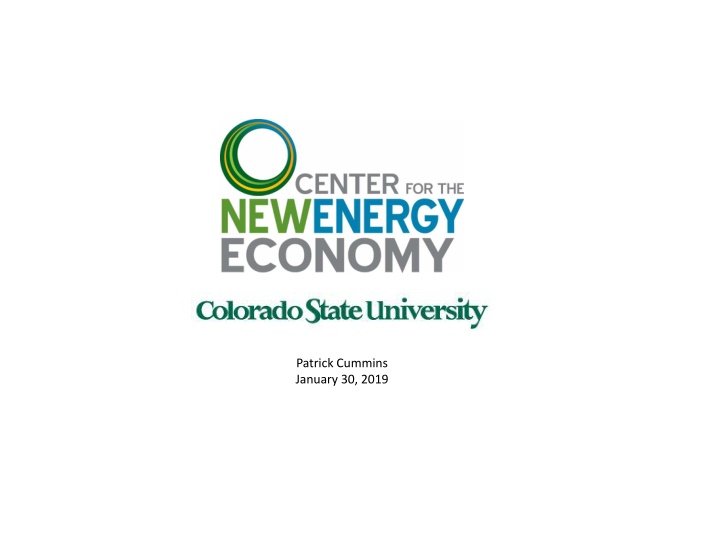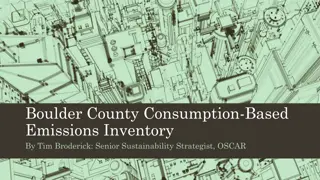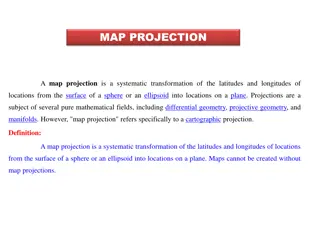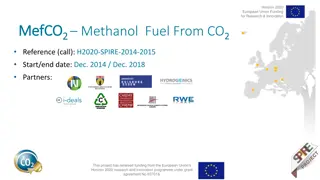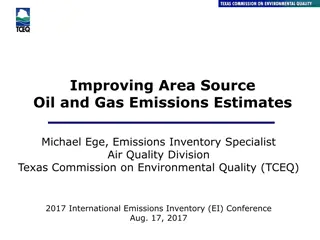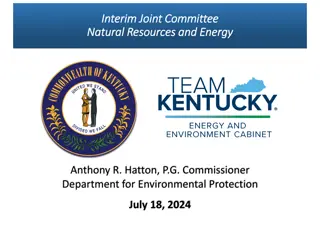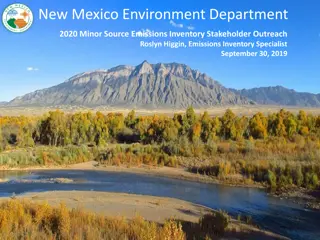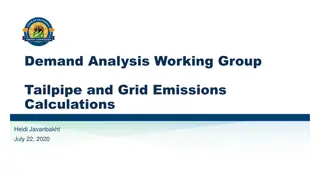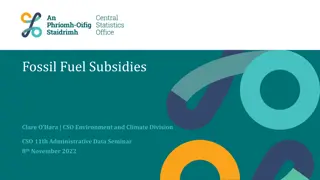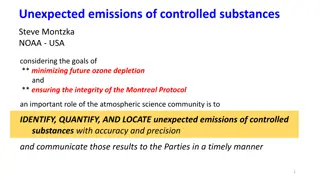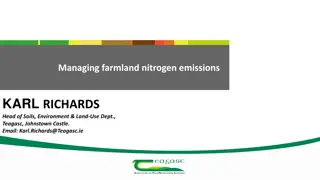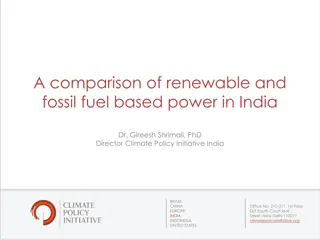Analysis of Fossil-Fired EGUs in Western States: Emissions Projection & Data Review
Compile comprehensive data on fossil-fired EGUs in 13 Western states from 2014-2017, focusing on plant characteristics, emissions, and future projections for 2028 considering closures, fuel switching, and regulatory controls. Review and correct data inconsistencies, incorporate new control measures and fuel switches, and highlight key findings from the data review process.
Download Presentation

Please find below an Image/Link to download the presentation.
The content on the website is provided AS IS for your information and personal use only. It may not be sold, licensed, or shared on other websites without obtaining consent from the author.If you encounter any issues during the download, it is possible that the publisher has removed the file from their server.
You are allowed to download the files provided on this website for personal or commercial use, subject to the condition that they are used lawfully. All files are the property of their respective owners.
The content on the website is provided AS IS for your information and personal use only. It may not be sold, licensed, or shared on other websites without obtaining consent from the author.
E N D
Presentation Transcript
Patrick Cummins January 30, 2019 1
Project Tasks Compile a comprehensive database of information on the fleet of fossil-fired EGUs in 13-Western states (circa 2014-2017) that contains information on the plants operating characteristics and emissions; and Develop a projection of 2028 EGU emissions that incorporates expected plant closures, fuel switching, and additional controls required under a rules on the books scenario. 2
2014 to 2017 Data Review Questions Review data for your state/company and provide any corrections. The 2014 data will be used in WRAP s baseline modeling exercise Flag any data that is not representative of the unit s current operations especially in terms of capacity factor (gross load) or emissions rate. Is the 2017 emissions rate reflective of current (or soon to be installed) controls for NOx and/or SO2 at each unit. If new controls were installed in 2017 that are not fully reflected in that year s data, or if there are new controls in 2018 or 2019, please describe those controls, note the timing of their installation/operation, and provide a best estimate of the unit s emission rate once the new controls are fully operational. Flag any units that switched from coal to gas during 2014-2017 and the date of that switch, or any units that may switch fuel sometime between now and 2028. The 2014-2017 data will be used to construct a representative profile of each unit s current operation, both in terms of capacity factor and emissions rate. 3
Responses to Data Review Received From: APS AZ DEQ Basin Black Hills Great River Energy MDU Minnkota MT DEQ NV DEP OR DEQ Otter Tail PacifiCorp Platte River PSCo SRP TEP and UNS Tri-State WA Ecology 4
Highlights from Data Review 2014-17 CAMD data is accurate Respondents identified a number of EGUs that are not in the CAMD data base due to size, age, or other reasons. In many cases, data for these units was provided. Years with outages, overhauls, or which are not representative for other reasons were identified by respondents. All the information provided in response to these two questions will be included in the final project report. Are there any concerns about attributing responses to individual respondents? Current controls (2017-19) not fully reflected in 2017 data were identified and incorporated into the analysis, along with units that have switched from coal to natural gas. 5 We will review the resulting emission profiles on this call.
Caveats Analysis to date addresses coal units only. We will discuss how best to proceed with analysis and projections for the fleet of natural gas generators. ID and CA no coal units; WA and OR no coal units in 2028 2018 data will soon be available and will be reviewed to ensure any important updates are incorporated. Analysis is limited to NOx and SO2 emissions, with a primary emphasis on NOx emissions. Western coal units are mostly well-controlled for SO2 When asked why he robbed banks, Willie replied, I rob banks because that s where the money is. 6
Western Power Sector Emissions of SO2 & NOx: Coal v. Gas 6% 7
SO2: -83% NOX: -64% CO2: -2% (-22% since 2008)
SO2: -80% NOX: -70% CO2: -11% (-10% since 2008) 10
2017 NOx Emissions - WECC 6.7% 11.3% 5.6% 7.3% 36.7% 21.3% 11.1% 2017-19 Controls & Fuel Switches Planned Retirements Potential Retirements No Post Combustion Controls SCR INSTALLED SNCR INSTALLED GAS PLANTS 11
2017 SO2 Emissions - WECC 1.4% 7.3% 31.5% 21.4% 23.6% 14.4% 2017-19 Controls & Fuel Switches Planned Retirements Potential Retirements No Post Comb. Controls SCR SNCR 12
REVIEW PLANNED RETIREMENTS SPREADSHEET 13
WECC Net Generation All Sources (data through Oct 2018) 000 MWHrs - EIA 800000 750000 700000 650000 600000 550000 500000 450000 400000 2015 2016 2017 2018 14
WECC Net Generation by Source 12-month rolling average 000 MWHrs - EIA 240000 190000 140000 90000 40000 coal natural gas nuclear hydro renewables 15
Factors influencing future generation and power sector emissions in the West Coal unit retirements / additional pollution controls Capacity factors coal and gas units Gas prices New gas units Nuclear retirement (Diablo Canyon (CA) 2024-25) Hydro variability Cost of Renewables / federal tax policy for renewables State climate and energy policies Energy efficiency / demand-side management programs Electrification (esp. transportation) Transmission capacity / additions Regional wholesale electricity markets (EIM, day-ahead, ISO / RTO) Energy storage technologies and costs Grid modernization Federal energy and environmental policy Utility IRPs Corporate and city renewable energy and sustainability goals 16
It's tough to make predictions, especially about the future. Yogi Berra 17
A proposed framing for 2028 Modeling/predicting total generation and the generation mix on the Western grid in 2028 is beyond the scope of this project. Luckily, that s not our responsibility. Our job is to provide a realistic estimate of unit-by-unit emissions under an on-the-books scenario to evaluate regional haze impacts. Scenario 1 provided here = 85% nameplate capacity factor for coal units Captures the potential impact on the clean days of most concern Remaining units may see higher capacity factors with so many coal plants retiring A reasonable screening scenario. Assumptions can be modified if more a detailed evaluation of impacts and controls is required. We will review this scenario and discuss other options you may want to consider 18
Methodology Nameplate Capacity x 8760 hrs x 0.85 = MWhrs Heat Rate = mmbtu/kWh Emission rate = lbs/mmbtu Apply proper conversion factors (e.g., 2000 lbs = 1 ton) Then: MWhrs x Heat Rate x Emission Rate = Tons Per Year 19
Discuss next steps & March 12 Workshop Any changes to assumptions regarding planned coal unit retirements? Other 2028 Scenarios that should be considered for the coal units? How should we project emissions from existing gas generation? Should we include and new gas units? . Discuss March 12 workshop agenda and objectives Phase II of this project 21
